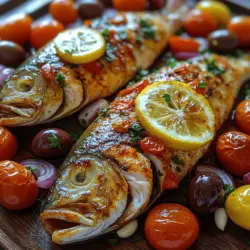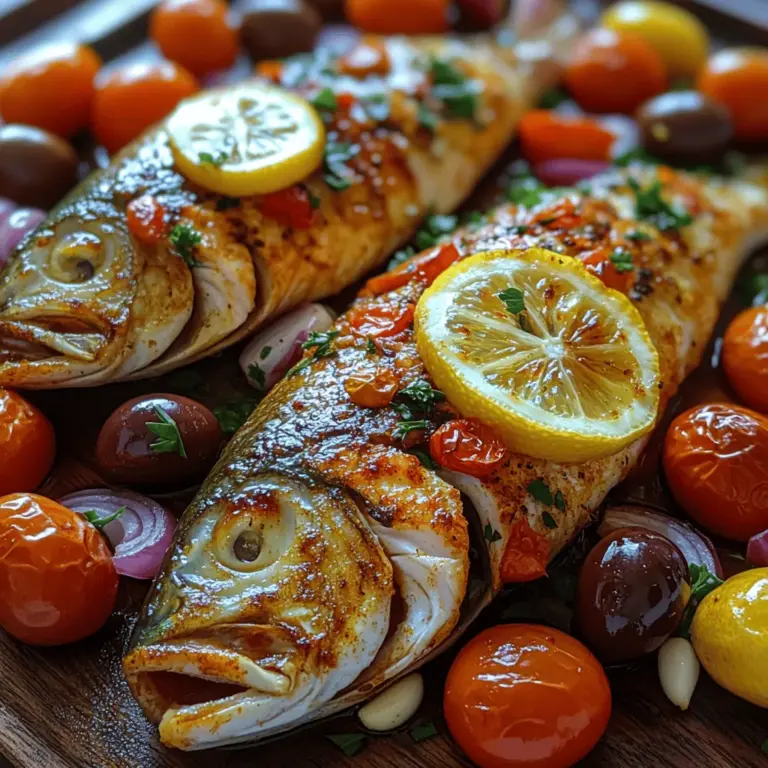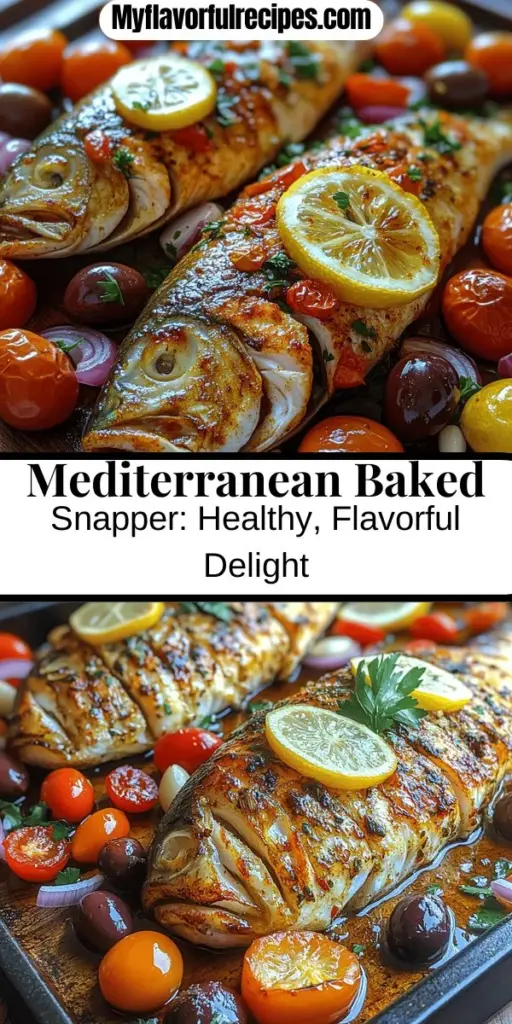Introduction
Mediterranean cuisine is celebrated not only for its tantalizing flavors but also for its numerous health benefits. This vibrant culinary tradition, rooted in the countries bordering the Mediterranean Sea, emphasizes fresh ingredients, wholesome meals, and a balanced diet. Characterized by an abundance of fruits, vegetables, whole grains, legumes, nuts, and healthy fats, Mediterranean cooking provides a feast for the senses while supporting various aspects of health, including heart health, weight management, and overall well-being.
One dish that perfectly encapsulates this culinary heritage is Mediterranean Baked Snapper. This dish marries the delicate, flaky texture of fresh snapper with a medley of colorful vegetables, aromatic herbs, and the richness of extra virgin olive oil, resulting in a meal that is as nutritious as it is delicious. The beauty of Mediterranean Baked Snapper lies not only in its bright, vibrant flavors but also in its ease of preparation, making it an ideal choice for both novice cooks and seasoned chefs looking to whip up a quick yet impressive dinner.
Fresh ingredients play a pivotal role in Mediterranean cooking, and this dish is no exception. The use of seasonal produce and high-quality fish brings out the best in the flavors, making every bite a delightful experience. In this article, we will explore the key components of Mediterranean Baked Snapper, from the star ingredient to the supporting cast of flavors that make this dish a must-try.
Understanding Snapper: The Star Ingredient
Snapper, particularly red snapper, is a prized fish in Mediterranean cuisine. Known for its mild flavor and firm texture, snapper holds up well to various cooking methods, including baking, grilling, and frying. When selecting snapper for your Mediterranean Baked Snapper, freshness is critical. Look for fish with clear, bright eyes, shiny skin, and a mild ocean scent. Fresh snapper should be firm to the touch and should not have a strong fishy odor.
Nutritionally, snapper is a powerhouse. It’s a lean source of protein, making it an excellent choice for those looking to maintain a healthy diet. Each serving of snapper is rich in omega-3 fatty acids, which are known to support heart health, lower inflammation, and boost brain function. Additionally, snapper is a good source of essential vitamins and minerals, including vitamin B12, selenium, and potassium. These nutrients contribute not only to physical health but also to overall well-being, making snapper a smart choice for any meal.
Moreover, sustainability is an important consideration when it comes to seafood consumption. Red snapper populations have faced overfishing in the past, but many fisheries now use sustainable practices to ensure the long-term health of snapper stocks. When purchasing snapper, look for certifications from reputable sources that indicate sustainable fishing practices. By choosing sustainably sourced fish, you can enjoy your Mediterranean Baked Snapper while also supporting the health of our oceans.
The Mediterranean Influence
The Mediterranean diet is more than just a way of eating; it’s a lifestyle that promotes health, vitality, and enjoyment of food. This culinary tradition is characterized by a rich tapestry of flavors, textures, and colors, drawing from the diverse cultures and landscapes of the Mediterranean region. From the sun-kissed shores of Greece to the bustling markets of Morocco, Mediterranean cuisine showcases a variety of cooking techniques and ingredients that celebrate the bounty of the land and sea.
Key ingredients commonly found in Mediterranean dishes include olive oil, fresh vegetables, legumes, grains, fish, and herbs. Olive oil, particularly extra virgin olive oil, is a staple in Mediterranean cooking, prized for its robust flavor and health benefits. This healthy fat is rich in monounsaturated fats, which have been linked to lower cholesterol levels and reduced risk of heart disease.
In addition to olive oil, an array of fresh vegetables such as tomatoes, zucchini, eggplant, and bell peppers contribute to the colorful and nutrient-dense meals typical of the Mediterranean diet. Legumes such as chickpeas and lentils add protein and fiber, while whole grains like quinoa, bulgur, and whole wheat bread provide essential nutrients and energy. The inclusion of fish, particularly fatty fish like salmon and mackerel, introduces valuable omega-3 fatty acids into the diet, promoting heart and brain health.
Herbs and spices are also fundamental to Mediterranean flavors, infusing dishes with herbal notes and aromatic qualities. Oregano, thyme, basil, and parsley are just a few examples of the fresh herbs that elevate the taste of Mediterranean recipes while also providing health benefits, including anti-inflammatory properties and antioxidant effects.
The health benefits of a Mediterranean diet are well-documented. Numerous studies have shown that adhering to this way of eating can lead to improved cardiovascular health, reduced risk of chronic diseases, and even a longer lifespan. The emphasis on whole, minimally processed foods and healthy fats, combined with regular physical activity and social connections around meals, makes the Mediterranean lifestyle a holistic approach to well-being.
Ingredients Breakdown
To create a stunning Mediterranean Baked Snapper, it is essential to understand the role and significance of each ingredient used in the recipe. Below, we will break down the key components that contribute to the dish’s flavor profile and nutritional value:
1. Snapper: As previously mentioned, fresh snapper is the centerpiece of this dish. When selecting snapper, prioritize quality and freshness to ensure the best flavor and texture. If red snapper isn’t available, other varieties such as yellowtail or tilapia can also work well.
2. Extra Virgin Olive Oil: This rich and flavorful oil is a cornerstone of Mediterranean cooking. Extra virgin olive oil is made from the first pressing of olives, yielding a high-quality oil that retains the natural flavors and health benefits of the olives. Its fruity notes and peppery finish complement the snapper beautifully while adding heart-healthy fats.
3. Lemons: Fresh lemons are integral to Mediterranean cuisine, adding brightness and acidity to dishes. The juice and zest of lemons enhance the flavor of the snapper while also providing vitamin C and antioxidants. The citrusy notes help to balance the richness of the olive oil and fish.
4. Garlic: A staple in Mediterranean recipes, garlic not only adds depth of flavor but also offers numerous health benefits. Known for its anti-inflammatory and immune-boosting properties, garlic enhances the taste of the dish while contributing to overall wellness.
5. Cherry Tomatoes: These sweet, juicy bursts of flavor lend a vibrant color to the dish. Cherry tomatoes are rich in vitamins A and C, as well as antioxidants like lycopene. Their natural sweetness balances the savory notes of the snapper and other ingredients.
6. Red Onion: Adding a subtle sweetness and crunch, red onion complements the flavors of the dish while also providing essential nutrients such as vitamin C, B vitamins, and antioxidants.
7. Kalamata Olives: These dark, briny olives bring a unique flavor and texture to the dish. Rich in healthy fats and antioxidants, Kalamata olives add a delightful saltiness that enhances the overall flavor of the Mediterranean Baked Snapper.
8. Herbs (Oregano and Thyme): Fresh oregano and thyme are essential for infusing the dish with aromatic flavors. Both herbs are rich in antioxidants and offer various health benefits, including anti-inflammatory effects and digestive support.
9. Seasoning (Salt and Pepper): Simple yet essential, seasoning with salt and pepper elevates the dish by enhancing the natural flavors of the ingredients. Use sea salt or kosher salt for the best results.
10. Fresh Parsley: As a garnish, fresh parsley adds a pop of color and an aromatic finish to the dish. It’s also packed with vitamins K and C, making it a nutritious addition to your meal.
In summary, Mediterranean Baked Snapper is a dish that showcases the best of Mediterranean flavors and health benefits. From the fresh snapper to the vibrant vegetables and aromatic herbs, each ingredient plays an essential role in creating a delicious and wholesome meal. In the next section, we will dive into the step-by-step instructions for preparing this delightful dish, ensuring that you can bring the flavors of the Mediterranean into your own kitchen.
Stay tuned for the next part, where we will explore the cooking process and tips for achieving the perfect Mediterranean Baked Snapper!
{{image_1}}
Preparation Steps in Detail
Preheating the Oven: Importance of Temperature in Cooking Fish
To begin your Mediterranean Baked Snapper, preheat your oven to 400°F (200°C). Preheating is a crucial step in the cooking process, especially for fish. An adequately heated oven ensures that the fish cooks evenly and maintains its moisture, preventing it from drying out. By starting with a hot oven, you also help to create a nice crust on the snapper’s skin, enhancing both texture and flavor.
Preparing the Snapper: Techniques for Cleaning and Scaling
Before you can bake your snapper, it’s essential to clean and scale it properly. If you’ve purchased a whole snapper, you’ll need to start by removing the scales. Using the back of a knife or a fish scaler, hold the fish firmly and scrape from the tail towards the head. Make sure to do this over a sink or a large bowl, as scales can scatter easily.
Next, rinse the fish under cold running water to remove any remaining scales and internal debris. If you haven’t asked your fishmonger to gut the fish for you, make a small incision along the belly and carefully remove the innards, ensuring to clean the cavity thoroughly. Pat the snapper dry with paper towels, as this will help the marinade adhere better.
Creating the Marinade: Balancing Flavors for Optimal Taste
The marinade is where the magic begins. In a bowl, combine olive oil, fresh lemon juice, minced garlic, chopped fresh herbs (such as parsley and oregano), salt, and pepper. This combination of ingredients provides a harmonious balance of acidity, richness, and aromatic flavors that will enhance the natural taste of the snapper. The olive oil contributes healthy fats, while the lemon juice adds brightness and acidity, which are characteristic of Mediterranean cuisine.
Marinating the Fish: The Science Behind Marination and Its Benefits
Once your marinade is prepared, it’s time to marinate the fish. Place the cleaned snapper in a large resealable plastic bag or a shallow dish, then pour the marinade over it, ensuring the fish is well-coated. Allow the snapper to marinate for at least 30 minutes, though longer (up to 2 hours) can deepen the flavors. The science behind marination lies in the ingredients; the acid from the lemon juice helps to break down proteins, tenderizing the fish while infusing it with flavor.
Assembling the Vegetables: Flavor Combinations and Textural Contrasts
As the snapper marinates, prepare your vegetables. Common choices for this dish might include sliced bell peppers, zucchini, cherry tomatoes, and red onions. These vegetables not only add vibrant colors but also provide a range of textures and flavors, from the sweetness of the bell peppers to the slight crunch of zucchini. Toss the vegetables with a drizzle of olive oil, salt, and pepper to enhance their natural sweetness before arranging them in the baking dish.
Arranging in the Baking Dish: Tips for Presentation and Even Cooking
To achieve an aesthetically pleasing presentation, lay the marinated snapper on top of the bed of vegetables in a large baking dish. Ensure that the fish is centered and that the vegetables are evenly distributed around it. This arrangement not only looks beautiful but also allows the flavors to meld together as they cook. If you have any remaining marinade, drizzle it over the top of the fish and vegetables for added flavor.
Baking the Dish: Understanding Cooking Times and Methods for Fish
Place the baking dish in the preheated oven and bake for approximately 25-30 minutes, depending on the size of your snapper. A general rule of thumb is to cook fish for about 10 minutes per inch of thickness. The fish should be opaque and flake easily with a fork when it’s done. If you’re unsure, you can also use a meat thermometer; the internal temperature should reach 145°F (63°C).
Checking for Doneness: How to Tell When Snapper is Perfectly Cooked
To check if your Mediterranean Baked Snapper is perfectly cooked, look for the telltale signs: the flesh should be opaque and separate easily from the bone. If you have cooked it with the skin on, it should also be crispy and golden brown. If you’re using a whole fish, make a cut near the thickest part of the flesh; if it’s still translucent or gelatinous, it needs more time.
Serving Suggestions: Pairing with Side Dishes for a Complete Meal
Once your snapper is baked to perfection, it’s time to serve! For a complete Mediterranean experience, consider pairing your dish with a side of couscous or quinoa. These grains complement the flavors of the fish and vegetables beautifully. Additionally, a fresh arugula or mixed greens salad drizzled with lemon vinaigrette adds a refreshing contrast. A glass of crisp white wine, such as a Sauvignon Blanc, pairs exceptionally well with the dish, enhancing the overall dining experience.
Flavor Profiles and Cooking Techniques
The Role of Baking in Enhancing Flavors
Baking is an excellent method for cooking fish, as it allows the flavors to meld without the need for excessive oil or butter. The dry heat of the oven helps to caramelize the natural sugars in the vegetables while sealing in the moisture of the snapper. This technique not only intensifies the dish’s flavor but also retains the fish’s delicate texture.
How the Combination of Ingredients Creates a Balanced Dish
The Mediterranean Baked Snapper is a textbook example of how to create a balanced dish. The fish provides a lean source of protein, while the vegetables deliver essential vitamins and minerals. The herbs and spices add aromatic depth, and the olive oil contributes healthy fats. Together, these elements create a wholesome meal that satisfies both the palate and nutritional needs.
Discussion on Alternative Cooking Methods (Grilling, Steaming)
While baking is a popular option, don’t hesitate to explore alternative cooking methods. Grilling the snapper can impart a smoky flavor and create beautiful grill marks, while steaming preserves its moisture and tenderness. Each method offers unique taste experiences, so consider your preferences and available equipment when deciding how to prepare your fish.
Health Benefits of Mediterranean Baked Snapper
Nutritional Analysis of the Dish as a Whole
Mediterranean Baked Snapper is not only delicious but also nutritious. A single serving typically provides a rich source of protein, healthy fats, and a variety of vitamins and minerals. The fish itself is low in calories and high in essential nutrients, making it an excellent choice for those looking to maintain a balanced diet.
Benefits of Omega-3 Fatty Acids from Fish
One of the standout health benefits of consuming snapper is its content of omega-3 fatty acids. These essential fats are known for their cardiovascular benefits, including lowering blood pressure and reducing inflammation. Regular consumption of omega-3s is also linked to improved brain health and cognitive function, making this dish a smart addition to your diet.
Advantages of Including Vegetables in the Meal
The inclusion of a variety of vegetables not only enhances the dish’s flavor but also boosts its nutritional profile. Vegetables are packed with antioxidants, fiber, and essential vitamins that support overall health. For instance, bell peppers are rich in vitamin C, while zucchini offers a low-calorie source of hydration and fiber. Together, they complement the fish, making your meal both satisfying and health-conscious.
Low-Calorie, High-Nutrition Profile of the Recipe
Mediterranean Baked Snapper is a low-calorie dish that doesn’t skimp on flavor or nutrition. By focusing on fresh ingredients and avoiding heavy sauces, this recipe allows you to enjoy a hearty meal without the added calories. This makes it an ideal choice for those looking to maintain a healthy lifestyle while enjoying flavorful cuisine.
Cultural Significance of Seafood in Mediterranean Diets
Historical Context of Seafood Consumption in Mediterranean Regions
Seafood has held a significant place in Mediterranean cuisine for centuries. The Mediterranean Sea is abundant with a variety of fish and shellfish, making it a staple food source for coastal communities. Historically, fish was considered a vital protein source, especially before the rise of livestock farming. The tradition of consuming seafood has been carried through generations, influencing culinary practices and cultural celebrations.
The Role of Fish in Traditional Mediterranean Festivities and Gatherings
Fish often plays a central role in Mediterranean festivities and gatherings. In many cultures, serving a whole fish is a symbol of abundance and prosperity. Dishes like Mediterranean Baked Snapper are frequently featured during family gatherings, religious celebrations, and holiday feasts. This cultural significance underscores the joy of sharing meals, highlighting the connection between food and community.
Conclusion
In conclusion, the Mediterranean Baked Snapper is more than just a meal; it’s a celebration of flavors, health, and cultural heritage. This recipe captures the essence of Mediterranean cuisine, offering a delightful blend of fresh fish and vibrant vegetables that are both nourishing and satisfying. As you explore this dish, take a moment to appreciate its health benefits, from the omega-3 fatty acids to the array of vitamins found in the vegetables.
We encourage you to dive deeper into the world of Mediterranean recipes, embracing the wholesome ingredients and cooking techniques that promote a balanced diet. Cooking with fresh, high-quality ingredients not only enhances your meals but also enriches your time spent with loved ones. So, gather your family and friends, share this delicious Mediterranean Baked Snapper, and enjoy the joy of cooking together.



